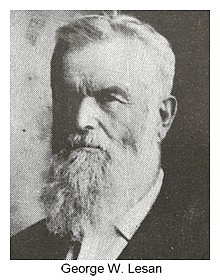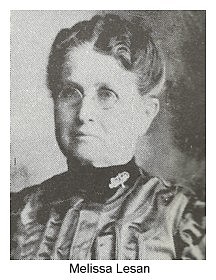|
Lesanville ~ Ramsey Farm

Lesanville, photograph by Sharon R. Becker, August of 2009
 The Ramsey Farm, located north of Highway 2 east of Mount Ayr, is a 180-acre historical working farm and village
capturing the flavor of rural American life between the 1800's to early 1950's. In 2001, Paul Ramsey and Phil Burmeister
established the Ramsey Farm Foundation to restore the farmstead of Jennie and George Vance and the Lesanville village.
The Ramsey Farm, located north of Highway 2 east of Mount Ayr, is a 180-acre historical working farm and village
capturing the flavor of rural American life between the 1800's to early 1950's. In 2001, Paul Ramsey and Phil Burmeister
established the Ramsey Farm Foundation to restore the farmstead of Jennie and George Vance and the Lesanville village.
Early in the winter of 1855, George W. Lesan came from Illinois to Ringgold County and purchased land in Poe Township.
He was joined by his brother David M. Lesan and brother-in-law Carlos Lee and their families, arriving on May 3, 1855.
A village sprang up around the farmsteads and a post office was established.
Lesanville became a rail town along the CB&Q Railroad in 1879, situated approximately 5 miles east of Mount Ayr.
Lesanville School
Lesanville Schoolhouse, photograph by Sharon R. Becker, August of 2009
The first classes at Lesanville were held in a log cabin. Later, during the winter of 1860-61, classes were held in the home of David Lesan. In 1861, the first Lesanville School was built in 1861 with Mr. Randles as the first teacher.
A new schoolhouse was built on the southeast corner in section [which is the current location of the schoolhouse at Lesanville] in the mid-1880's.
Mrs. Vera Daughton was the teacher for the 1954-55 year at the Lesanville School.
The Lesanville School [Poe Township No. 1] closed in 1958 and was moved from its original site in 1959 to South Taylor Street in Mount Ayr where it is used as a home.
The sign on the Lesanville School which was moved onto the site gives the year "1873."
Lesanville Church
Lesanville Church, photograph by Sharon R. Becker, August of 2009
At first, the Lesans held services and Sunday School in their homes. After the schoolhouse was erected, religious services
were moved into the new building.
The original Methodist Episcoal Church at Lesanville was built in 1891 and was affiliated with the Kellerton Methodist Church.
Services at Lesanville were held on Sunday afternoons. By 1931, attendence had dwindled so the church was sold to Art
DeVires of Kellerton. The building was torn down and the lumber moved away.
The church currently at Lesanville was introduced to the project during the summer of 2002.
Axtell House
Axtell House, photograph by Sharon R. Becker, August of 2009
George Axtell (1854-1947) built a Prairie Gothic styled frame house on a hilltop one-quarter of a mile west of the Lesanville School in
1903. He was the son of Hiram and Mary (Brewer) Axtell who had moved to Lesanville in 1874. His wife Malinda "Lina"
(1860-1944) was the daughter of
Christopher and Margaret (Cabaret) Saltzman. The Saltzmans moved from France to Lesanville in 1853. In the 1990's Ron Bice purchased the
farm from the Axtell family and donated the Axtell house to the Ramsey Farm Foundation in 2001. Restoration began immediately
to convert the house into a bed and breakfast, operating as the Lesanville Inn.
Axtell House, North Side, photograph by Sharon R. Becker, August of 2009
Uncle George's Barn
Lesanville Barn, photograph by Sharon R. Becker, August of 2009
Carriage House
Carriage House, photograph by Sharon R. Becker, August of 2009
The Carriage House is a replica of an early 1900's carriage house. It has an upstairs loft apartment accommodations
and a bunkhouse on the ground floor.
Heritage House
Heritage House, photograph by Sharon R. Becker, August of 2009
Sweet Home Cemetery
Sweet Home Cemetery, photograph by Sharon R. Becker, August of 2009
In 1872, George Lesan donated a plot of ground for burials. The first interment was Mr. and Mrs. J.P. Lesan's child.
In time there was a need for a larger cemetery. All of the bodies but two [belonging to families that had moved out of the
state] were removed and re-interred in the new cemetery
which was named Sweet Home Cemetery.
Lesanville Store/Post Office
Lesanville Store and Post Office, photograph by Sharon R. Becker, August of 2009
 George Lesan wrote to the U.S. Post Master General in Washington, D.C., asking for a post office to be established in his building
to serve the community. His request was granted and Melissa Lesan [George's wife] was appointed as the post mistress. Mail arrived by the
train until rural routes were later established. The post office at Lesanville operated from 1884 until 1899.
George Lesan wrote to the U.S. Post Master General in Washington, D.C., asking for a post office to be established in his building
to serve the community. His request was granted and Melissa Lesan [George's wife] was appointed as the post mistress. Mail arrived by the
train until rural routes were later established. The post office at Lesanville operated from 1884 until 1899.
The Lesan Family
SOURCE: Kellerton, Iowa: A History to 1981. Pp. 131-32. 1981.
Photographs by Sharon R. Becker, August of 2009
Submission by Sharon R. Becker, November of 2013


|


